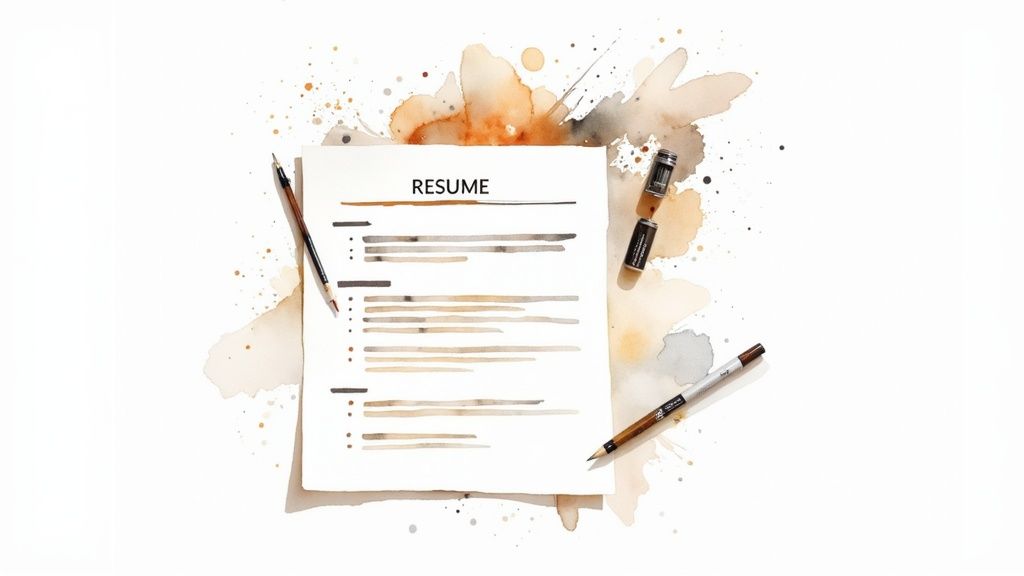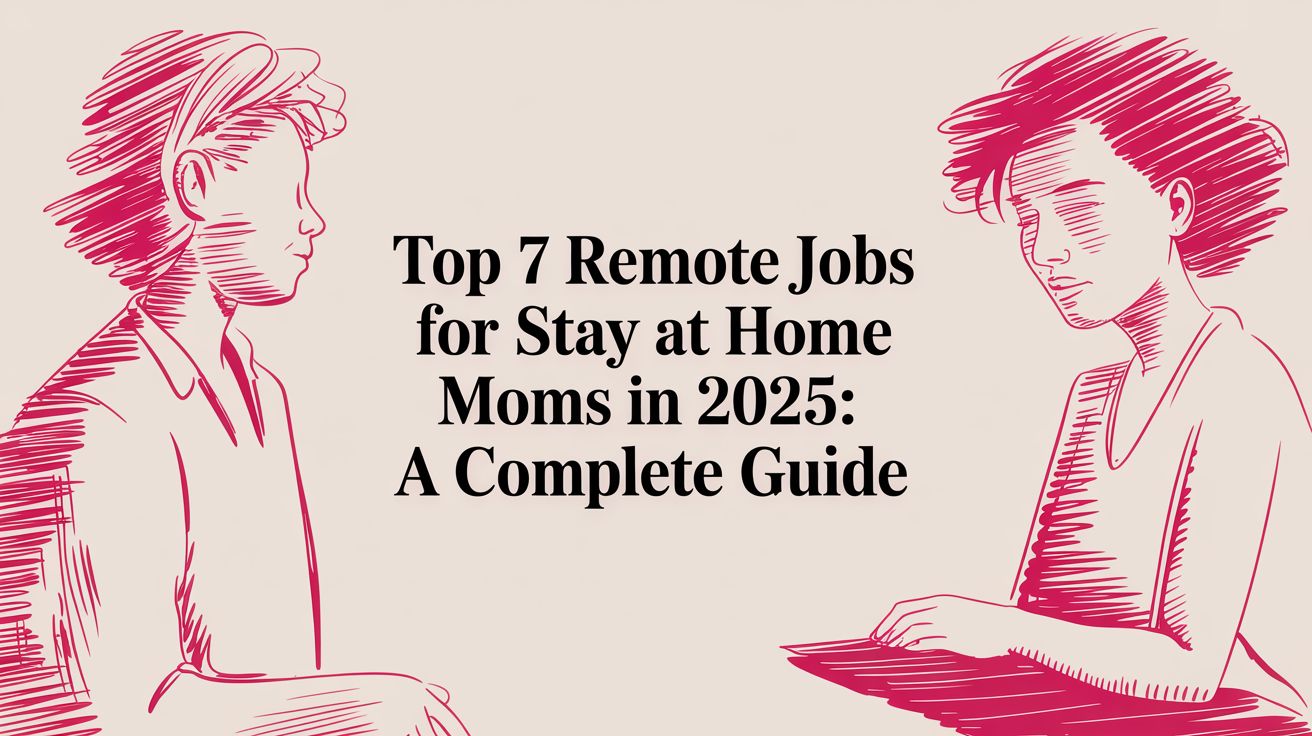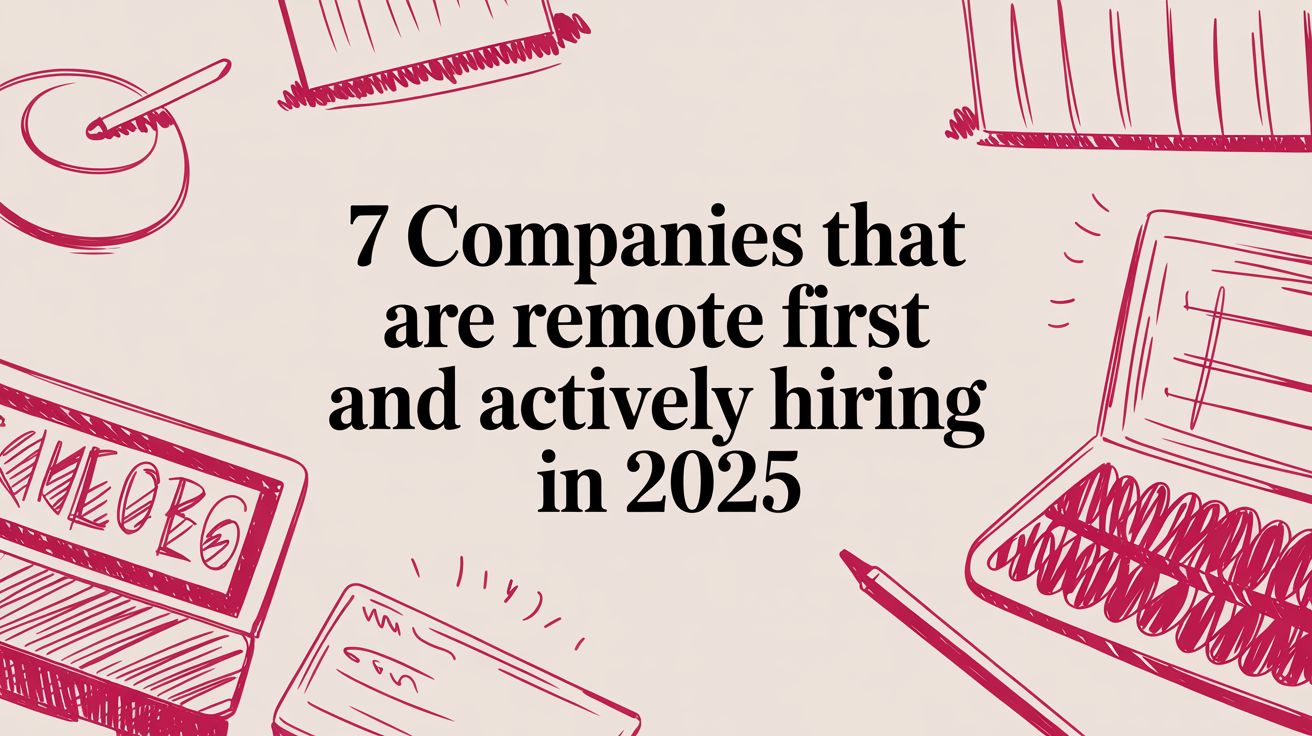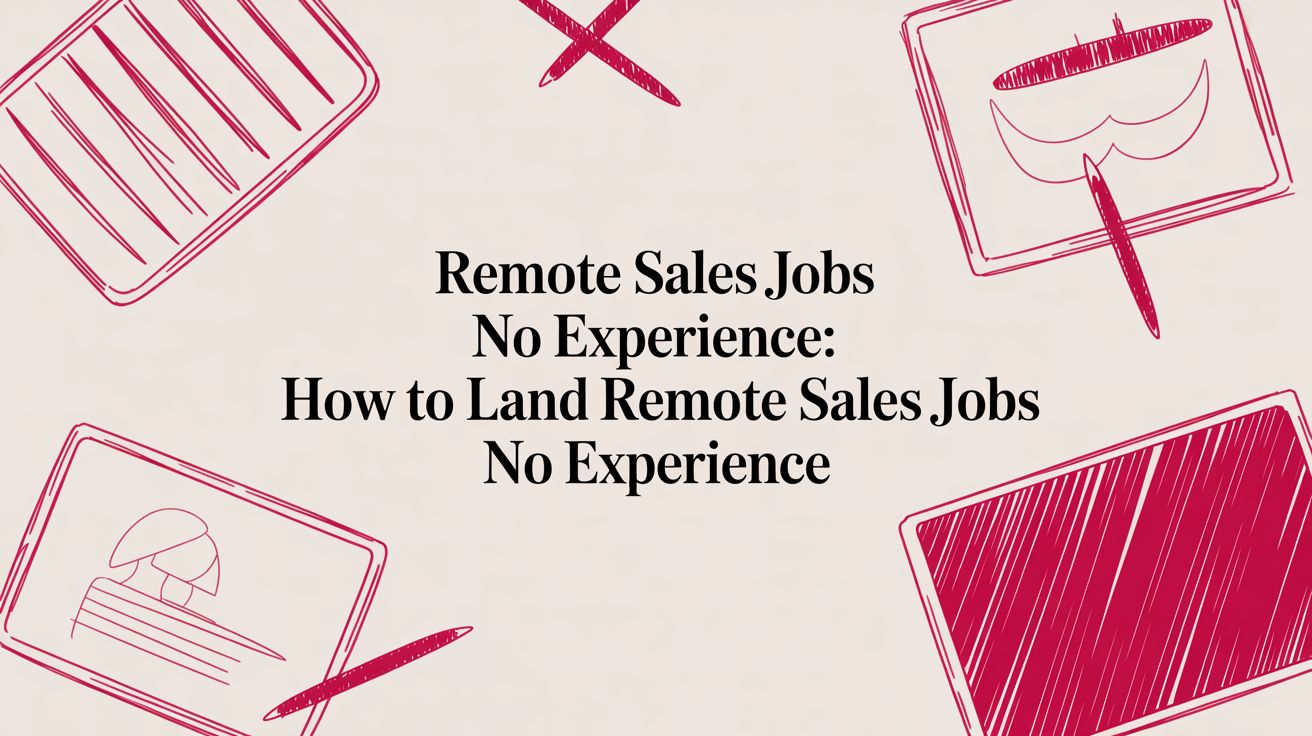Craft a Winning Resume for Remote Jobs
Max
When you’re applying for a remote job, your resume needs to do more than just list your previous roles. It has to tell a story—one that proves you can thrive without someone looking over your shoulder. The best remote resumes I’ve seen all do the same thing: they scream self-discipline, highlight comfort with digital collaboration tools, and show off tech skills with real, concrete examples.
That’s what gets a hiring manager’s attention. They want to see proof you can deliver results from anywhere.

Understanding the Remote Resume Mindset
Building a resume for remote work isn’t just about tweaking a few words here and there. It requires a completely different mindset. You’re not just documenting a career path; you’re building a case that you’re a reliable, communicative, and productive professional who doesn’t need a physical office to get things done.
The job market has shifted dramatically. Before 2020, only about 4% of U.S. job listings were for remote positions. Fast forward to today, and that number has skyrocketed to over 15%, making the competition for these roles fiercer than ever.
From Traditional to Remote-Focused
To really stand out, you have to look at every single section of your resume through a remote-first lens. This isn’t about adding a clumsy “Remote Work” section. It’s about weaving the principles of remote success into the very fabric of your resume.
This means reframing your standard resume sections to emphasize qualities like autonomy, digital fluency, and proactive communication. A hiring manager should read your resume and have zero doubts about your ability to jump into a distributed team and hit the ground running. If you’re struggling to make that shift, getting some professional resume help can offer tailored strategies to make your experience shine.
The biggest difference is proof. A traditional resume says, “Managed projects.” A remote-ready resume shows, “Managed projects using Asana and Slack, coordinating a distributed team across three time zones to deliver 15% ahead of schedule.” See the difference?
Your digital presence is also a huge piece of the puzzle. A strong LinkedIn profile is just as important as your resume. A polished, professional headshot, for example, can make a huge first impression. It’s worth understanding what makes a good headshot for your career to ensure your online brand is on point.
To really nail this down, it helps to see a direct comparison. Here’s a look at how you can transform traditional resume sections to better fit what remote hiring managers are looking for.
Core Resume Sections and Their Remote Focus
Let’s break down how to reframe each part of your resume. This table shows the subtle but critical shifts in focus you need to make.
| Resume Section | Traditional Purpose | Remote Role Focus |
|---|---|---|
| Professional Summary | General career overview | Highlighting remote experience, key collaboration tools, and self-management skills. |
| Work Experience | Listing duties and tasks | Showcasing quantifiable achievements accomplished with minimal supervision and digital tools. |
| Skills Section | Broad list of abilities | Emphasizing specific software, communication platforms, and asynchronous work methodologies. |
| Contact Information | Location and phone | Including a LinkedIn profile URL, portfolio link, and sometimes your time zone. |
Thinking this way forces you to translate your skills into the language of remote work, which is exactly what you need to do to land an interview.
How to Showcase Essential Remote Work Skills

Simply saying you’re a “great remote worker” won’t cut it anymore. Hiring managers are looking for concrete proof that you can thrive without someone looking over your shoulder. They want to see evidence of sharp communication, rock-solid self-discipline, and a natural fluency with the tools of the trade.
The secret is to transform those vague claims into punchy, data-backed bullet points. When you do, your resume suddenly tells a powerful story about your impact.
Master the Art of Asynchronous Communication
Showing you’re a pro at communicating across different time zones is a huge differentiator. It’s not just about sending emails; it’s about making sure work flows smoothly when no one is online at the same time.
Instead of saying you’re a good communicator, show it. Think about projects where you had to coordinate with a distributed team and find a number to attach to it.
- Coordinated daily project updates on Slack across three continents, cutting down response lag by 40%.
- Built and maintained our team’s entire project documentation in Confluence, which kept everyone aligned and ensured 100% version accuracy.
- Led weekly stand-ups using recorded Loom videos, which helped us make decisions 20% faster by eliminating unnecessary meetings.
See the difference? These points don’t just list skills; they prove the positive impact you had.
Prove Your Project Management Independence
When your manager is a thousand miles away, autonomy is everything. You have to prove you can own your work from start to finish. This is where you can talk about your experience with platforms like Asana, Trello, or Jira.
I’ve learned that handling complex sprints on my own forces you to get really good at spotting potential roadblocks early and hitting every milestone without fail.
Let your achievements speak for themselves.
- Managed a six-week product development cycle in Asana from kickoff to launch, coming in 15% under budget.
- Single-handedly developed and rolled out a new remote onboarding program that slashed new hire ramp-up time by two weeks.
Each bullet point should scream “I get things done without hand-holding.” That’s what hiring managers want to see.
Quantify Your Tool Proficiency
Listing a bunch of software in a “Skills” section is lazy. The real magic happens when you connect each tool to a specific achievement. This turns an abstract skill into a tangible result.
To help you get started, here are some common remote work skills and how you can frame them to show your impact.
Top Remote Work Skills to Feature
| Skill | How to Showcase It | Example Bullet Point |
|---|---|---|
| Asynchronous Chat | Reference the volume of communication and how you improved team clarity or speed. | Managed 200+ weekly Slack threads across project channels, boosting team clarity by 30%. |
| Task Management | Use metrics from projects you managed, like completion rates or deadlines met. | Organized and tracked 50+ interdependent tasks in Asana for a major feature launch, achieving a 95% on-time completion rate. |
| Collaboration Docs | Show how you maintained accuracy and encouraged team adoption of shared resources. | Owned the team’s Confluence wiki of 120+ pages, maintaining a 100% up-to-date status for all critical documentation. |
| Video Reporting | Highlight how your video updates saved time or made decision-making more efficient. | Recorded 12 weekly Loom updates for stakeholders, which cut our status meeting time in half. |
A few quick tips can make every tool you mention pop:
- Kick off each bullet point with a strong action verb and a specific number.
- Always tie your use of a tool back to a real business outcome.
- Got a story about using a tool to solve a crisis? Tell it!
It also helps to show you’re aware of broader industry trends. With hybrid and remote work models now common for 35-40% of U.S. employees, demonstrating these skills proves you’re ready for the modern workplace. You can dive deeper into the data at Global Workplace Analytics.
And if you want to brush up on your skills, exploring different strategies for successful remote work is always a good idea.
Your Next Move
Alright, time to put this into practice. Open your resume right now and hunt down every vague phrase you can find. Your mission is to replace each one with a hard number, a specific tool, and a clear outcome.
Need a little more guidance on where to start? Check out this helpful comprehensive, detailed step-by-step guide to finding a remote job for more ideas.
Structuring Your Resume For Scannability And Impact

You’ve got mere seconds to grab attention. Whether it lands on a recruiter’s desk or goes through an ATS, the first thing anyone notices is how your resume looks.
A cluttered layout? Instant rejection. Think of your resume as a roadmap: if key details aren’t obvious at a glance, the reader will move on.
Choosing The Right Resume Format
Your work history should guide which style you choose. There’s no universal solution, but selecting the wrong one can bury your strengths.
Chronological Format
Lists roles from newest to oldest. Ideal if you’ve followed a steady path in one industry and want to highlight growth.Functional Format
Focuses on skills over dates. Handy for career changers or candidates with gaps, though some hiring managers remain skeptical.Hybrid Format
Perfect for remote roles. Start with a concise summary and core skills, then present your work timeline. This lets you showcase remote-friendly abilities right away, while still offering the familiar chronology recruiters expect.
In my experience, the hybrid resume delivers the best of both worlds—instantly highlighting why you’re a strong remote candidate without sacrificing clarity.
Designing For Maximum Readability
Once the format is set, clean design makes all the difference. A neat, professional appearance signals strong attention to detail—critical when you’re working off-site.
Think of white space as a tool. Proper margins, line spacing, and section breaks stop readers from feeling overwhelmed and let your achievements shine.
Keep these design rules in mind:
- Clean Typography: Choose fonts like Calibri, Arial, or Helvetica. Use 10–12 pt for body text.
- One-Page Focus: Unless you boast over ten years of highly relevant experience, stick to a single page.
- Clear Headings & Bullets: Labels such as Work Experience and Technical Skills guide the eye. Under each role, bullet points beat dense paragraphs every time.
16% of global companies are now fully remote, and countless others embrace hybrid setups. A well-structured resume respects a hiring manager’s time and aligns perfectly with this shift. For deeper insights, see Breeze.pm’s Remote Work Statistics.
Here’s a quick glance in table form:
undefined
| undefined | undefined |
|---|---|
This table above illustrates undefined details you’ll want to tailor for your own resume.
Strategically Placing Key Information
Certain details are non-negotiable for remote roles—make sure they stand out right at the top.
Contact Information Header
Elevate beyond name and email. Treat this section as your professional hub.
| Element to Include | Why It Matters for Remote Jobs | Example |
|---|---|---|
| LinkedIn Profile URL | Acts as a digital handshake—gives recruiters a deeper look at your background. | linkedin.com/in/your-name |
| Portfolio/GitHub Link | Offers direct proof of your work—essential for designers and developers. | yourportfolio.com |
| Time Zone or General Location | Simplifies scheduling. Skip the full street address—“EST-based” will suffice. | San Francisco, CA (PST) |
By structuring your layout, design, and contact details with intention, you won’t just pass the initial scan—you’ll tell a compelling story about why you belong in their remote team.
Navigating Applicant Tracking Systems
Before your resume ever lands on a hiring manager’s desk, it must clear the digital gatekeeper: the ATS. Picture it as a no-nonsense bouncer, scanning resumes for the right keywords, skills, and clean formatting. Miss a cue, and your application never makes the cut.
Over 75% of resumes never pass that initial screen. It’s rarely about lacking qualifications—it’s about failing to speak the ATS’s language. Clearing this hurdle is the first win in your remote job search.
Deconstructing The Job Description
Every job posting doubles as your keyword roadmap. It spells out exactly what the ATS—and the hiring team—wants to see. Treat the description like a detective would a crime scene.
Start by copying the full posting into a document. Then:
- Hard Skills: Note tools like Asana, Slack, Jira, Salesforce, or languages such as Python and JavaScript.
- Soft Skills: Watch for phrases tied to remote work: “asynchronous communication,” “self-motivated,” “time management,” “cross-functional collaboration.”
- Company Language: Grab words that embody culture—think “fast-paced environment” or “agile methodology.”
Highlight every instance. That list becomes your custom checklist for keywords that must appear on your resume.
Weaving Keywords Naturally Into Your Resume
Dropping terms into a jumble of bullet points won’t cut it. Instead, thread each keyword through your accomplishments so it reads like a story of impact.
Say a remote marketing role demands “SEO strategy,” “Google Analytics,” and “content creation.” Rather than a vague line like:
- Managed marketing campaigns.
You’d write:
- Developed and executed a comprehensive SEO strategy that boosted organic traffic by 45%, leveraging Google Analytics to refine content creation efforts.
This does two things: it checks the ATS box and gives recruiters concrete proof of your success.
Your resume needs to speak two languages: the keyword-focused dialect of the ATS and the results-oriented tone hiring managers understand. Master both, and you’re unstoppable.
By understanding how automated resume screening software parses your application, you shift from simply listing tasks to showcasing achievements that win that digital review.
Common Formatting Mistakes That Wreck ATS Scans
Even with perfect keywords, a fussy layout can trip up the ATS. Keep it straightforward:
- Fancy Fonts and Graphics: Use web-safe fonts—Arial, Calibri, Helvetica. Ditch images, logos, charts, or text boxes.
- Unusual Section Headers: Stick to titles like “Work Experience,” “Skills,” “Education.” Creative labels confuse the parser.
- Tables and Columns: They look neat but scramble text order for machines. Go single-column.
- Header/Footer Content: Some systems ignore anything outside the main body. Keep contact details front and center.
A simple, single-column format with clear headings and bullet points is your best friend.
undefined
Below is a table titled “undefined” that provides additional context:
| undefined |
|---|
This placeholder table can be replaced with specific data or examples tailored to your experience.
And that wraps up our quick look at formatting pitfalls. Tidy this up, and you’re ready for the next step: the interview. For hands-on pointers to nail your video chat, dive into our essential guide on remote interview tips: https://remotefirstjobs.com/blog/remote-interview-tips
Real-World Examples of Winning Remote Resumes
Theory is great, but seeing a resume that actually worked is a game-changer. Let’s move past the abstract advice and dig into a couple of real-world examples that successfully landed remote jobs. We’ll break down exactly what makes them so effective, from the way they frame achievements to their keyword strategy.
These examples are your blueprint. Whether you have a straightforward career path or need to connect seemingly unrelated experiences, they show how to spin your history into a compelling story that screams “hire me for your remote team.”
Here’s a quick look at what a clean, scannable remote resume looks like.

Notice how the clean layout and distinct sections for skills, tools, and experience help a hiring manager see the candidate’s remote qualifications in just a few seconds.
Example One: The Remote Marketing Manager
First up, let’s look at “Anna,” a marketing pro with five years under her belt. Her last job was hybrid, but she was determined to land a fully remote Content Marketing Manager role.
Anna’s biggest challenge? Proving her hybrid experience was more than enough for a fully remote team. She had to show she could drive serious results without a manager physically looking over her shoulder.
What Anna Did Right
- Quantified Everything: Instead of a vague “managed social media,” she got specific: “Grew organic social media engagement by 45% in six months by implementing a data-driven content strategy.” Boom.
- Tied Tools to Outcomes: She didn’t just list tools like Asana, Slack, and HubSpot. She connected them to wins. For instance: “Coordinated a cross-functional product launch using Asana, ensuring all deliverables from a distributed team of 10 were completed on schedule.”
- Led with a Remote-First Summary: Her professional summary hit the nail on the head right away. It started with, “Results-driven Content Marketing Manager with 5+ years of experience, including 3 years in a hybrid environment, specializing in building and executing content strategies for distributed teams.”
Anna’s resume is brilliant because every single bullet point answers the hiring manager’s silent question: “Can you do this job from anywhere?” The metrics and tools she mentions provide undeniable proof.
This simple shift in framing turned a standard marketing resume into a powerful argument for her remote-readiness. For more ideas like this, check out these work-from-home resume samples to see these principles in action across different industries.
Example Two: The Remote Software Developer
Next, let’s break down the resume of “David,” a software developer gunning for his first fully remote position. Having only worked in traditional offices, David needed to translate his skills into a language that screamed remote-ready.
His main hurdle was the lack of any official “remote” experience on his resume. He got around this by focusing on the processes and tools he was already using—the very same ones that power remote development teams everywhere.
How David Showcased His Remote Potential
- Emphasized Asynchronous Work: David smartly highlighted his deep experience with GitHub for version control and code reviews. One bullet point read, “Collaborated with a team of 8 developers on a complex codebase via GitHub, conducting asynchronous code reviews that improved code quality by 20%.”
- Highlighted the Remote Tech Stack: He made sure to call out his daily use of Jira for ticket management and Slack for team communication. This instantly showed recruiters he was already fluent in the digital language of remote tech teams.
- Showcased Autonomous Project Ownership: He framed his projects to emphasize his independence. For example: “Independently owned the development of a new user authentication module from initial design to deployment, meeting all project milestones ahead of schedule.”
This strategy was incredibly effective. David proved that while his desk was in an office, his workflow was already perfectly aligned with the best practices of a distributed engineering team.
Key Takeaways You Can Apply Today
Both Anna and David nailed it by being strategic. They didn’t just list their job duties; they curated their experience to perfectly match the unique demands of a remote role.
Here’s how you can do the same:
- Audit Your Experience: Look back at your past roles. Find every single time you worked independently, used a collaboration tool like Slack or Trello, or communicated with colleagues who weren’t sitting next to you.
- Add Numbers Everywhere: Quantify your impact. How much time did you save? By what percentage did you boost a key metric? Numbers are the universal language of achievement and they cut through the noise.
- Frame Your Summary Carefully: Use that prime real estate at the top of your resume to state your goal and immediately highlight your most relevant remote-friendly skills.
By dissecting these successful resumes, you can see that landing a great remote job isn’t about having the perfect background. It’s about skillfully presenting the experience you already have.
Common Questions About Remote Job Resumes
Even when you have a solid plan for your resume, a few tricky questions always seem to pop up. Let’s tackle some of the most common ones I hear from job seekers. Getting these details right can make all the difference.
How Should I List My Location?
This is probably the question I get asked the most. My advice? Ditch the full street address. It’s totally unnecessary in today’s world and, frankly, a bit of a privacy risk. You just need to provide enough info to be helpful.
If a job is open to anyone in the United States, something like “San Francisco, CA (PST)” or “Miami, FL (EST-based)” is perfect. This immediately tells the hiring manager your primary time zone, which is a huge deal for coordinating meetings and workflows on a distributed team.
Is a Professional Summary Still Necessary?
Absolutely. I’d even argue it’s more critical for a remote job resume. Think of it as your elevator pitch—it’s your first and best chance to signal that you’re built for remote work right from the get-go.
Use this prime real estate to highlight your years of experience in remote or hybrid settings. Mention the key collaboration tools you live in (like Asana or Slack) and drop a line about your self-discipline. It perfectly sets the stage for all the accomplishments you’ll detail later.
Your summary should answer the recruiter’s very first question: “Can this person thrive working remotely?” A strong opening statement immediately confirms you get the unique demands of working independently and are ready to jump in.
Which Specific Tools Should I Mention?
Be strategic here. Don’t just dump every piece of software you’ve ever touched into a list. That just creates noise. Instead, zero in on the tools that are most relevant to remote collaboration and, more importantly, to the specific job you’re after.
I recommend prioritizing tools that fall into these buckets:
- Project Management: Asana, Jira, Trello, Notion
- Communication: Slack, Microsoft Teams, Zoom
- Documentation: Confluence, Google Workspace, SharePoint
The real key, as we’ve talked about, isn’t just listing them. It’s about weaving them into your achievements in the work experience section. That’s what gives them powerful context.
Answering these questions is a big step, but if you’re still in the early stages, our guide on how to find remote work can give you a broader roadmap for your entire job search.
Ready to find your next opportunity? At Remote First Jobs, we connect talented professionals like you with thousands of verified remote-first companies. Start your search today!


